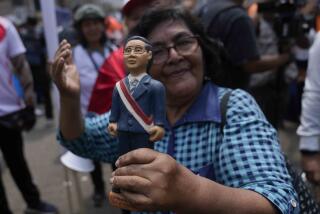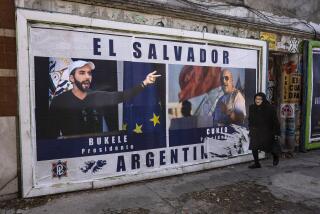Caudillo Castro
- Share via
On Jan. 1, 1959, when Fidel Castro led his guerrilla army into Havana, many people saw him as the symbol of a revolution that could eventually sweep across Latin America. Thirty years later the Cuban dictator is an anachronism not just in Latin America but in the socialist world as well.
The Cuban revolution changed some things for the better. Cubans are better educated and healthier than during the corrupt and brutal Batista dictatorship that Castro overthrew. Cuba also is more prominent in international affairs than might normally be expected of a poor Caribbean island of only 10 million people.
But Cubans also lost most of their freedom to the rigid political and economic system that Castro imposed on them. His state security apparatus keeps close tabs on peoples’ daily lives, down to the neighborhood level. Only in the last few years has Castro begun releasing some of the hundreds of political prisoners whom he jailed after the revolution. Castro has not diversified Cuba’s economy, which remains as dependent on sugar as it was before the revolution. Without aid from the Soviet Union, estimated at $14 million per day, Cuba would come to an economic standstill.
The failures of highly centralized socialist economies are so obvious that most Marxist countries are trying to change. China is opening itself to greater trade with capitalists. The Soviet Union, under Mikhail S. Gorbachev, seeks to restructure its economy and open its closed society. But Castro stubbornly refuses to admit any merit in Gorbachev’s policies of perestroika and glasnost. In a speech last year Castro insisted that Havana must follow “a different course” from Moscow’s.
Whatever the course may be, it is not obvious to the rest of Latin America, where Castro-style dictatorships are on the wane. Now that Chile’s Gen. Augusto Pinochet has been voted out of his presidency in a plebiscite, the only other major Latin dictator left on the scene is Paraguay’s 76-year-old Alfredo Stroessner. As time passes, those who regard Castro as the very personalization of the communist menace should realize that he is less a Marxist revolutionary than an old-style Latin American caudillo , or strongman.
Most Latin Americans no longer regard Castro as a real threat, as evidenced by his being invited to presidential inaugurals in Mexico, which had kept him at arm’s length, and Ecuador and Venezuela, which had even refused to maintain diplomatic relations with Cuba. They realize that time has passed Castro by.
So there is good reason for the State Department to continue its efforts to improve relations with Cuba. As long as Castro is around, dealings between the two nations can never be as close as they were before 1959. But more cooperation with Cuba can make it easier to strike deals with Castro when necessary, as recently happened in Angola. It could also make life easier for the many U.S. citizens who still have relatives on the island and would like to be in contact with them. Most important, any influence that the United States exerts in Cuba increases the pressure on Castro to open the nation’s society and economy. And any movement in that direction lays the groundwork for a freer Cuba once Castro passes from the scene.
More to Read
Sign up for Essential California
The most important California stories and recommendations in your inbox every morning.
You may occasionally receive promotional content from the Los Angeles Times.













